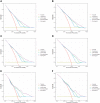Predictive Value of the Log Odds of Negative Lymph Nodes/T Stage as a Novel Prognostic Factor in Bladder Cancer Patients After Radical Cystectomy
- PMID: 35928878
- PMCID: PMC9343753
- DOI: 10.3389/fonc.2022.895413
Predictive Value of the Log Odds of Negative Lymph Nodes/T Stage as a Novel Prognostic Factor in Bladder Cancer Patients After Radical Cystectomy
Abstract
Background: The effect of lymph node resection on the prognosis of bladder cancer (BLCA) patients receiving radical cystectomy should not be ignored. Our aim was to explore the prognostic value of the log odds of negative lymph nodes/T stage (LONT) and construct a more effective nomogram based on LONT to predict cancer-specific survival (CSS) in postoperative BLCA patients.
Methods: Patients diagnosed with BLCA after radical cystectomy between 2004 and 2015 in the Surveillance, Epidemiology, and End Results (SEER) database were enrolled. We randomly split (7:3) these patients into the primary cohort and internal validation cohort. 86 patients from the First Affiliated Hospital of Nanchang University were collected as the external validation set. Univariate and multivariate cox regression analyses were carried out to seek prognostic factors of postoperative BLCA patients. According to these significantly prognostic factors, a simple-to-use nomogram was established for predicting CSS. Their performances were evaluated by using calibration curves, the concordance index (C-index), the receiver operating characteristic (ROC) curves, and decision curve analysis (DCA). In addition, different risk groups were tested by Kaplan-Meier curves and log-rank tests.
Result: Whether in cancer-specific survival (CSS) or overall survival (OS), LONT was an independent and significant prognostic factor. Through further screening, the ultimate nomogram of CSS was composed of nine independent prognostic factors including LONT, age, race, tumor size, histologic type, T stage, N stage, summary stage and chemotherapy. The C-index of nomogram in the primary cohort, internal and external validation cohort were 0.734, 0.720 and 0.728, respectively. The AUC of predicting CSS at 3 and 5 years were 0.783 and 0.774 in the primary cohort and 0.781 and 0.781 in the validation cohort. The results of calibration and DCA showed good concordance and clinical applicability. Significant differences (P < 0.05) were displayed in CSS among different risk groups.
Conclusion: LONT was regarded as a novel and reliable prognostic factor. Compared with the AJCC staging system, the established nomogram based on LONT can more effectively predict the prognosis of BLCA patients after radical cystectomy.
Keywords: SEER; bladder cancer; log odds of negative lymph nodes/T stage; nomogram; prognosis.
Copyright © 2022 Chen, Zhan, Chen, Jiang, Wan, Fu and Chen.
Conflict of interest statement
The authors declare that the research was conducted in the absence of any commercial or financial relationships that could be construed as a potential conflict of interest.
Figures






Similar articles
-
Survival nomogram for high-grade bladder cancer patients after surgery based on the SEER database and external validation cohort.Front Oncol. 2023 Jun 16;13:1164401. doi: 10.3389/fonc.2023.1164401. eCollection 2023. Front Oncol. 2023. PMID: 37397381 Free PMC article.
-
Nomogram based on the log odds of negative lymph node/T stage can predict the prognosis of patients with colorectal cancer: a retrospective study based on SEER database and external validation in China.BMJ Open. 2024 Dec 20;14(12):e083942. doi: 10.1136/bmjopen-2024-083942. BMJ Open. 2024. PMID: 39806584 Free PMC article.
-
The log odds of negative lymph nodes/T stage: a new prognostic and predictive tool for resected gastric cancer patients.J Cancer Res Clin Oncol. 2021 Aug;147(8):2259-2269. doi: 10.1007/s00432-021-03654-y. Epub 2021 May 18. J Cancer Res Clin Oncol. 2021. PMID: 34003367 Free PMC article.
-
Development and validation of a Log odds of negative lymph nodes/T stage ratio-based prognostic model for gastric cancer.Front Oncol. 2025 Jun 3;15:1554270. doi: 10.3389/fonc.2025.1554270. eCollection 2025. Front Oncol. 2025. PMID: 40530015 Free PMC article.
-
Development and validation of a prognostic nomogram for predicting cancer-specific survival after radical cystectomy in patients with bladder cancer:A population-based study.Cancer Med. 2020 Dec;9(24):9303-9314. doi: 10.1002/cam4.3535. Epub 2020 Oct 16. Cancer Med. 2020. PMID: 33063464 Free PMC article.
Cited by
-
Survival nomogram for high-grade bladder cancer patients after surgery based on the SEER database and external validation cohort.Front Oncol. 2023 Jun 16;13:1164401. doi: 10.3389/fonc.2023.1164401. eCollection 2023. Front Oncol. 2023. PMID: 37397381 Free PMC article.
-
Recursive partitioning staging system based on the log odds of the negative lymph node/T stage ratio in colon mucinous adenocarcinoma.Front Immunol. 2024 Dec 20;15:1472620. doi: 10.3389/fimmu.2024.1472620. eCollection 2024. Front Immunol. 2024. PMID: 39759511 Free PMC article.
-
Nomogram based on the log odds of negative lymph node/T stage can predict the prognosis of patients with colorectal cancer: a retrospective study based on SEER database and external validation in China.BMJ Open. 2024 Dec 20;14(12):e083942. doi: 10.1136/bmjopen-2024-083942. BMJ Open. 2024. PMID: 39806584 Free PMC article.
-
Prognostic model for log odds of negative lymph node in locally advanced rectal cancer via interpretable machine learning.Sci Rep. 2025 Mar 7;15(1):7924. doi: 10.1038/s41598-025-90191-0. Sci Rep. 2025. PMID: 40050297 Free PMC article.
References
-
- Masson-Lecomte A, Vordos D, Hoznek A, Yiou R, Allory Y, Abbou CC, et al. . External Validation of Extranodal Extension and Lymph Node Density as Predictors of Survival in Node-Positive Bladder Cancer After Radical Cystectomy. Ann Surg Oncol (2013) 20(4):1389–94. doi: 10.1245/s10434-012-2753-0 - DOI - PubMed
LinkOut - more resources
Full Text Sources

